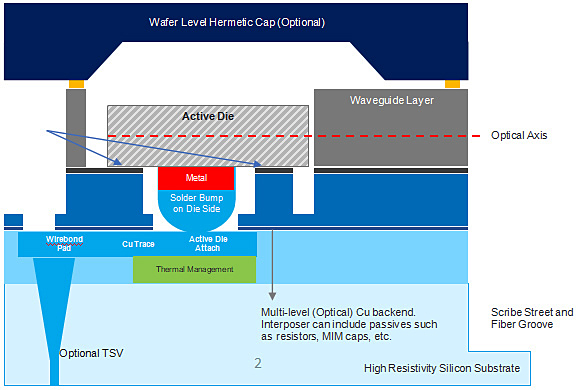POET Announces First Flip-Chip DML Lasers

Flip-chip assembly enables single-chip, fully integrated optical engine to be produced at wafer-scale
Photonics company POET Technologies has completed and tested its high-speed Directly Modulated Laser (DML) designs using a distributed feedback (DFB) structure and successfully 'flip-chipped' these lasers onto the company’s Optical Interposer platform (pictured above).
The flip-chip assembly technique enables a true single-chip, fully integrated Optical Engine to be produced at wafer-scale, resulting in the lowest-cost, smallest-size 100G CWDM4 Optical Engine with a form factor of 9mm x 6mm, while including banks of four lasers, four monitor photodiodes, four high speed photodiodes, a multiplexer, demultiplexer, taps for power monitoring and features supporting a self-aligned fiber attach unit.
“Without being able to flip-chip the lasers, we would be unable to assemble Optical Engines at wafer-scale, which is the single most important driver of cost. Wafer-scale processing enables the production of high unit volumes at low incremental costs, ultimately allowing us to reduce the cost of building photonics devices by 25 percent to 40 percent compared to conventional approaches,” stated Suresh Venkatesan, chairman and CEO of POET. “Following our successful demonstration of this flip-chip assembly process, POET can now readily incorporate these lasers and other active devices into derivative optical engine configurations, supporting data communications applications such as 200G CWDM4, 100G CWDM6, and 100G LR4, telecom applications such as 5G, as well as other applications that could benefit from the small size and low cost of our platform technology.”
Four DML lasers are commonly used in 100G transceiver applications, a key initial target market for POET’s Optical Interposer, enabling high speed optical communication in the 2 to 10 km range. Operating at speeds of 25 GPS, POET’s family of four DML lasers of different wavelengths are the first known commercial 25G DFB-type DML lasers to utilise a flip-chip process to passively align and bond to electronic and optical circuitry on the interposer platform, while maintaining optimal performance.
Given the estimated total available market (TAM) for 100G transceivers of approximately $2.5 billion, POET believes that its recently formed JV company, SuperPhotonics Xiamen, can achieve annual revenue of over $100 million within this single market segment in the 2024-25 time frame.



































